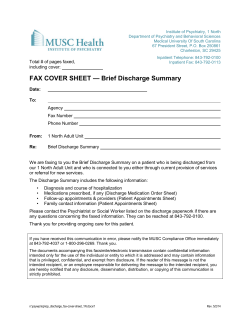
Core Measures What you need to know Quality, Accreditation, & Patient Safety Department
Core Measures What you need to know Quality, Accreditation, & Patient Safety Department What is a core measure? An evidenced based indicator that is used to measure the quality of patient care. 2 Why do Hospitals Perform Core Measures? • To provide the best care to our patients according to evidence based research. • The hospital’s results are reported to the Joint Commission and CMS where they are compared to other hospitals. • Receive higher reimbursement from Medicare and other payers. • Hospitals that do not participate in the initiative will receive a reduction of 2 percent in their Medicare Annual Payment 3 Clinical Focus Areas • Heart Failure (HF) • Acute Myocardial Infarction (AMI) • Pneumonia (PN) • Surgical Care Improvement Project (SCIP) 4 Heart Failure Measures • Discharge Instructions (6 key components): – – – – – – Diet Activity level Follow-up appt. What to do if symptoms worsen Weight monitoring Discharge Medications • Evaluation of Left Ventricular Systolic Function • Angiotensin Converting Enzyme Inhibitor (ACEI) or Angiotensin Receptor Blocker ( ARB) for Left Ventricular Systolic Dysfunction (LVSD) • Beta-blocker prescribed at discharge for LVSD 5 Why are we here today? #1 Reason: The PATIENT It isn’t just about the numbers…. it is about the right care every time. Proper care must be reflected in the Medical Record with the appropriate and specific information 6 What can physicians do to help? • Improve documentation: – Use pre-printed orders – Document contraindication such as ACEI / ARB, Beta-blockers, foleys, antibiotics, etc. • Understand the discharge process and what documentation is needed from you – ex. Medications per Medication Reconciliation What can physicians do to help? • Realize you can impact patient outcomes. • Be a part of the process…work with the hospital team on implementations. • Be aware of the specific metrics for AMI, HF, PNE, and SCIP. • Communicate frequently with hospital team (Nursing, Quality, Case Management, etc.) Examples of No and Yes of proper documentation Reimbursement per Value Based Purchasing program (VBP) Each Yes = $ 56, 000/Patient Each No = $ 0/Patient 9 Yes Use the right Forms YES Form C290jr Enter all required information NO Not appropriate State the indication 11 NO Missing information Form C568 12 Yes Complete forms correctly D/C Order Dictation Summary No When dictating please state: “Discharge Medications per D/C written order” Yes 14 Acute MI Measures • • • • • Aspirin at Arrival Aspirin Prescribed at Discharge ACEI or ARB for LVSD Beta-Blocker Prescribed at Discharge Fibrinolytic Therapy Received within 30 Minutes of Hospital Arrival • Primary Percutaneous Coronary Intervention (PCI) Received within 90 Minutes of Hospital Arrival • Statin Prescribed at Discharge 15 Yes Use the right Forms 16 Pneumonia Measures • Blood Cultures before first Antibiotic • Blood Cultures on arrival for ICU patients • Appropriate initial antibiotic selection • Influenza Vaccination • Pneumococcal Vaccination 17 No Antibiotic given first prior to BC Arrival time: 16:20 Blood culture done: 01:01 Levofloxacin given at 23:06 Yes Recommended Antibiotics for PN Use recommended lists SCIP • Prophylactic antibiotic within 1 hour prior to incision • Prophylactic antibiotic selection • Antibiotic discontinued within 24 hours after Anesthesia end time 20 Complete entire section Yes Yes Example: Colon Surgery Surgeon ordered correct ABX. Anesthesiologist administered Cefazolin (incorrect) No Wrong Antibiotic given Example of incorrect use of formPart 1 No Circling the selection No Example of incorrect use of form- Part 2 Should use same form for preop and postop order No Incorrect prophylaxis form used. Surgeon started Empiric ABX post op NOT a reason for continuing ABX documented YES Example of good documentation of reason to continue ABX SCIP • Cardiac Surgery Patients with Controlled 6 A.M. Postoperative Blood Glucose (< or = to 200mg/dl) • Perioperative Temperature Management (equal to or greater than 96.8 Fahrenheit/36 Celsius recorded within the 30 minutes immediately prior to or the 15 minutes immediately after Anesthesia End Time) • Urinary catheter removed on Postoperative Day 1 (POD 1) or Postoperative Day 2 (POD 2) SCIP • Surgery patients on Beta-Blocker therapy prior to arrival, who have received a Beta-Blocker during the perioperative period ( the day prior to surgery through POD 2 ) • Venous Thromboembolism (VTE) Prophylaxis Order and administered within 24 hrs prior to or 24 hrs after surgery VTE prophylaxis Must have order for mechanical and pharmaceutical or rationale for not to have it Elective Total Hip Replacement with a reason for not administering pharmacological prophylaxis Hip Fracture Surgery with a reason for not administering pharmacological prophylaxis Any of the following: •Intermittent pneumatic compression devices (IPC) •Venous foot pump (VFP) Any of the following: •Graduated Compression Stockings (GCS) •Intermittent pneumatic compression devices (IPC) •Venous foot pump (VFP) *Patients who receive neuraxial (spinal/epidural) anesthesia or have a documented reason for not administering pharmacological prophylaxis may pass the performance measure if either appropriate pharmacological or mechanical prophylaxis is ordered. 31 32 Stamp used to show reason for maintaining foley. Only physician documentation is accepted. • Foley must be removed by post-op day 2. • If there is a need for the foley to remain, document the reason for maintaining the foley catheter. CMS Core Performance Measures www.hospitalcompare.hhs.gov
© Copyright 2025





















